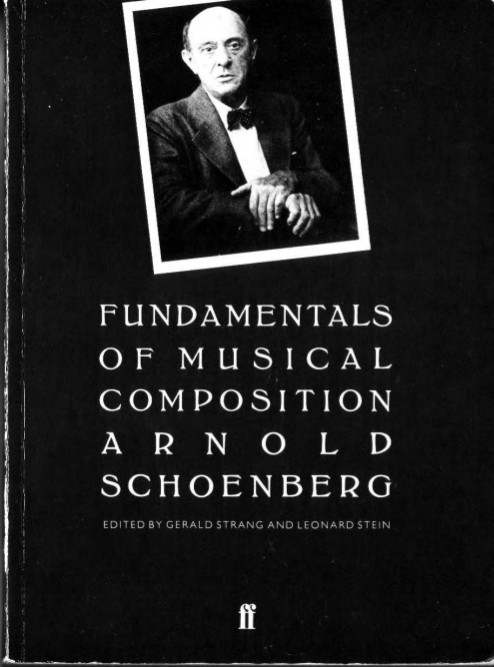Arnold Schoenberg: Fundamentals of Musical Composition (1967–) [EN, IT, ES, PT]
Filed under book | Tags: · composing, composition, music, music theory, sound recording

Fundamentals of Musical Composition represents the culmination of more than forty years in Schoenberg’s life devoted to the teaching of musical principles to students and composers in Europe and America. For his classes he developed a manner of presentation in which ‘every technical matter is discussed in a very fundamental way, so that at the same time it is both simple and thorough’. This book can be used for analysis as well as for composition. On the one hand, it has the practical objective of introducing students to the process of composing in a systematic way, from the smallest to the largest forms; on the other hand, the author analyses in thorough detail and with numerous illustrations those particular sections in the works of the masters which relate to the compositional problem under discussion.
Edited by Gerald Strang, with the collaboration of Leonard Stein
Introduction by Leonard Stein
Publisher Faber and Faber, London/Boston, 1967
ISBN 0571092764
256 pages
Fundamentals of Musical Composition (English, 1967, no OCR)
Elementi di composizione musicale (Italian, trans. Giacomo Manzoni, 1969, added on 2013-12-11)
Fundamentos de la composición musical (Spanish, trans. A. Santos, 1989, added on 2013-12-11)
Fundamentos da composição musical (Portuguese, trans. Eduardo Seincman, 1991/1996, added on 2013-12-11)
Richard Kostelanetz: Conversing with Cage, 2nd ed (1987/2003)
Filed under book | Tags: · aesthetics, art, biography, dance, music, music theory, radio, sound recording

Conversing with Cagedraws on over 150 interviews with John Cage conducted over four decades to draw a full picture of his life and art. Filled with the witty aphorisms that have made Cage as famous as an esthetic philosopher as a composer, the book offers both an introduction to Cage’s way of thinking and a rich gathering of his many thoughts on art, life, and music. John Cage is perhaps this century’s most radical classical composer. From his famous “silent” piece (4’33”) to his proclamation that “all sound is music,” Cage stretched the aesthetic boundaries of what could be performed in the modern concert hall. But, more than that, Cage was a provocative cultural figure, who played a key role in inspiring scores of other artists-and social philosophers-in the second half of the 20th century. Through his life and work, he created revolutions in thinking about art, and its relationship to the world around us. Conversing with Cageis the ideal introduction to this world, offering inthe artist’s own words his ideas about life and art. It will appeal to all fans of this mythic figure on the American scene, as well as anyone interested in better understanding 20th century modernism.
Edition 2
Publisher Routledge, 2003
ISBN 0415937922, 9780415937924
332 pages
Arnold Schoenberg: Theory of Harmony (1911–) [DE, IT, ES, EN, PT]
Filed under book | Tags: · composition, harmony, music, music theory, sound recording

“This book will come as a joy, a revelation, a warm reassurance. From this one book one might well learn less about harmony than about form, about aesthetics, even about life. Some will accuse Schoenberg of not concentrating on the topic at hand, but such an accusation, though well-founded, would miss the point of Theory of Harmony, because the heart and soul of the book is to be found in his vivid and penetrating digressions. They are the fascinating reflections of a great and humane musician who was a born writer as well.”
German edition
First published in 1911
Third edition, 1922
Publisher Universal Edition, Vienna
516 pages
English edition
Translated by Roy E. Carter, based on the third edition, published in 1922
Publisher University of California Press, 1983
ISBN 0520049446, 9780520049444
440 pages
Harmonielehre (German, 3rd Edition, 1922, added on 2013-12-11)
Manuale di armonia (Italian, trans. Giacomo Manzoni, 1963/1973, added on 2013-12-11)
Tratado de armonía (Spanish, trans. Ramon Barce, 1979, added on 2013-12-11)
Theory of Harmony (English, trans. Roy E. Carter, 1983, updated on 2012-8-3)
Harmonia (Portuguese, trans. Marden Maluf, 1999, added on 2013-12-11)

